Innovation in Biological Indicator Evaluator Resistometer Vessel Technology
The authors examine advances in the design and the application of biological indicator evaluator resistometer vessels used to measure the resistance of bacterial spores in monitoring sterilization processes.
Sterilization deals with the destruction of microorganisms by exposing materials to conditions that are rapidly lethal to them. The validation of these processes generally relies on the use of resistant microorganisms termed biological indicators (BIs) that are positioned within the sterilizer. The destruction of these microorganisms during validation confirms the lethality of the process for the routine use of the sterilizer. Routine sterilization must be sufficiently lethal to the bioburden expected on or in the materials being processed. Information about the process resistance of both the BI and bioburden is essential to understanding process effectiveness. Over- or under-estimating the resistance of either the indicator or the indigenous bioburden can lead to failed validation studies, potentially contaminated batches, sterility failure investigations, and other serious situations.
Determination of microbial resistance
Determining microbial resistance once was only the concern of BI manufacturers and firms producing terminally sterilized products. There are several instances in which the firm using BIs could benefit by making its own resistance determination. These situations arise when either spore strips or suspension indicators are used as follows:
- Spore strips are labeled by their manufacturer, with resistance based on their test methods and laboratory media. Differences in the methods and media at the end user's site can lead to altered resistance.
- Suspensions of BIs come with a labeled resistance as well. That value is for the specific lot when tested as a spore strip. BI manufacturers caution their customers that these values may change when the indicator is inoculated onto a different substrate.
- Elastomeric closures have been shown to alter the resistance of BI organisms dried on their surface as is currently expected in regulatory submissions
- Resistance determination and screening of bioburden organisms can be detected in presterilization sampling
- BI resistance is determined in support of cycle development, initial or revalidation of terminal sterilization processes
- Sterility-test and media-fill failure investigations sometimes incorporate concerns regarding the resistance of presterilization bioburden organisms.
BIER vessels
BI evaluation resistometer (BIER) vessels have been used for more than 50 years to measure the resistance of bacterial spores when monitoring steam-sterilization processes. The earliest designs of steam-BIER vessels were developed by food-processing technologists, and were based on the concept of retorts used in the food-processing industry. These steam retorts maintained a large volume and constant flow of steam under pressure in an environment in which BI units were quickly inserted and removed. This process provided a nearly instantaneous come-up and cool-down condition for the exposed samples.
Medical and pharmaceutical technologists developed BIER vessels around conventional autoclave technology. The autoclave is a steam-pressure vessel in which materials are placed into a chamber at ambient pressure. The door is closed, steam is admitted into the chamber, and steady-state conditions are achieved. With specially engineered systems using very small chambers, the system can achieve nearly instantaneous come-up and cool-down conditions.
These special sterilizers were almost exclusively custom designed. Today, commercial units are offered by a limited number of manufacturers. The Fedegari system (model FOB 3, Fedegari Autoclavi SpA, Povia, Italy) tested in this study is a 140-L laboratory steam autoclave with an accessory attachment that allows rapid sample insertion into a chamber at steady-state conditions and rapid removal of the sample. The chamber's internal sample guide can be removed from the interior of the unit, thus allowing the unit to be used as a standard laboratory autoclave. This BIER vessel design can be used not only for BIs, but also for chemical indicators and process-challenge devices.
The BIER vessel establishes a steady-state condition within a small sterilization chamber and relies on the rapid insertion and removal of samples for the conduct of the D-value determination. In its purest form, the BIER operates as a square wave system, in which the samples are instantaneously taken from ambient conditions, brought to the sterilizing condition, and returned to ambient conditions (see Figure 1). BIER-vessel standards for saturated steam mandate a maximum of 10 s for the come-up and come-down steps.
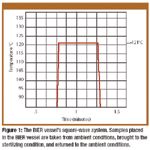
Figure 1: The BIER vessel's square-wave system. Samples placedin the BIER vessel are taken from ambient conditions, brought to thesterilizing condition, and returned to the ambient conditions.
In steam sterilization, exposure of samples to the sterilizing conditions may need to be extremely brief, especially when determining the resistance of bioburden isolates. Unfortunately, the insertion and removal of samples can alter the conditions of the test. The majority of BIER vessels use extremely small chambers for various reasons:
- Small chambers are all that are required to evaluate limited numbers of spore strips and inoculated components products.
- A small chamber is more easily brought to and from the desired sterilizing conditions. (An adjacent larger chamber is sometimes used as a reservoir for the sterilizing medium.)
- Smaller chambers are easier to maintain uniformly within the desired conditions.
Figure 2 shows a commercially available BIER vessel used for steam sterilization D-value determination. The use of a small chamber for the BIER has inherent limitations. The BIER vessel cannot be used for any other purpose. The expenditure of a substantial sum (approaching $100,000) for a single piece of equipment having only limited use as a BIER is certainly prohibitive. For this reason and perhaps no other, BIER vessels only are found at biological indicator manufacturers and some of the very large pharmaceutical firms.

Figure 2
The intent of the Fedegari FOB series design was to provide BIER capabilities meeting ANSI/AAMI/ISO 18472:2006 requirements in a fully functional laboratory sterilizer (1). This would allow major advantages over existing BIER vessels:
- When not used as a BIER, it could function as a steam sterilizer
- The availability of a steady state chamber provides typical BIER performance
- Based on a standard autoclave, it could be produced at a substantially lower price.
There were several other goals for the design: conversion from autoclave to BIER and back again without tools in less than 5 min, no adverse impact on the performance of the unit as a standard sterilizer, easy-to-use controls, and a simple gravity feed and discharge mechanism. These goals were accomplished by relatively minor modifications to the standard Fedegari FOB laboratory sterilizer (see Figure 3).
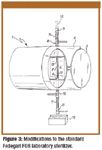
Figure 3
The Fedegari FOB laboratory sterilizer has several characteristics that make it ideally suited for use as a combination BIER and sterilizer. It has an internal circulating fan, driven by a magnetic coupling, which aids in distributing the sterilizing medium. It is rated for full vacuum and up to 3.5-bar internal pressure. It comes with a liquid-ring vacuum pump and is equipped with its own dedicated steam generator, thereby eliminating lengthy pipe runs. It also includes a highly capable process controller that can be integrated with a personal computer or network for data upload.
The Fedegari BIER system is available in several variations:
- As a fully configured laboratory sterilizer with or without its own steam supply
- As a field retrofit to an existing Fedegari FOB sterilizer
- As a field retrofit to an existing steam or gas sterilizer from any manufacturer
- As a hybrid BIER incorporating combined steam or gas capability in a single unit.
The ANSI/AAMI/ISO 18472:2006 standard entitled Sterilization of Health Care Product—Biological and Chemical Indicators: Test Equipment specifies "the requirements for the test equipment to be used to establish the response of chemical and BIs to critical process variables" (1). This article presents the parametric data collected on the Fedegari resistometer and compares it with this standard. In addition, the performance of the resistometer was evaluated (using BIs as a tool) by direct comparison with two Steris-manufactured resistometers.
Materials and methods
Resistometers. The Fedegari-manufactured resistometer is a model FOB 3 steam sterilizer (140 L) fitted with a device that allows the rapid insertion and removal of BIs into the chamber while charged and under pressure (see Figure 4). The device consists of a loading chamber, a guiding tube through the main chamber, and an exit chamber. The loading chamber is positioned on top of the resistometer. The biological indicators are gravity-fed through the vessel by the precise coordination of the series of valves. The system is computer controlled and allows the operator to program the exposure time. The system is capable of running prevacuum cycles by evacuation of the loading chamber before insertion of the BIs into the main chamber. A Kaye Digistrip datalogger using 10 thermocouples was used to monitor the chamber temperature.

Figure 4
The Steris (Joslyn)-manufactured resistometers (model SB-001 and model JS-BIER-STM, Steris Corp., Mentor, OH) meet the performance requirements as described in ANSI/AAMI/ISO 18472:2006. Only the load probe of the resistometers was used to monitor chamber temperature.
Parametric analysis. In each resistometer, exposures were performed in triplicate at temperatures from 121 to 129 °C. Parametric data collected from these cycles were analyzed using the ANSI/AAMI/ISO standard as guidance.

Table I. Description of biological indicators (BIs).
Biological indicators. Three types of BIs—spore strip, self-contained, and glass ampul—from three manufacturers were used (see Table I). Spore-strip BIs consisted of Geobacillus stearothermophilus spores inoculated onto paper carriers and packaged in glassine envelopes. Self-contained BIs consisted of G. stearothermophilus spores inoculated onto paper carriers placed into a thermoplastic vial that serves as a culture tube. A small glass ampul containing sterile culture medium and color indicator also was in the vial. Glass-ampul BIs consisted of G. stearothermophilus spores suspended in liquid culture medium and sealed inside a small, thin-walled, pharmaceutical-grade glass ampul. BIs were loaded into a cassette (see Figure 5) before insertion into the chamber. Upon completion of the cycle, the cassette was removed from the chamber.

Figure 5
D and Z value analysis. Spore strip survivor curve. In the Fedegari and Steris (JS-BIER-STM) resistometers, D 121-values were determined (in triplicate) on the spore strip BIs by the survivor-curve method according to ISO 11138 (2). The survivor-curve method involves subjecting the BIs to a series of incremental exposure times followed by enumeration of the surviving spores through the performance of a population assay. This method was chosen for the simplest BIs to evaluate the linearity of the curve in each resistometer. Testing was as follows:
- BI lot# S1—D 121-value determined in triplicate in Fedegari resistometer
- BI lot# S1—D 121-value determined in triplicate in Steris (JS-BIER-STM) resistometer.
Fraction negative. In each resistometer, D 121-values were determined (in triplicate) on the spore-strip BIs. In the Fedegari resistometer, D 124 and D 129-values were determined (in triplicate) on the spore-strip BIs.

Table II.Control specification of Fedegari and Steris resistometers.
In each resistometer, D-values were determined (in triplicate) at three temperatures using self-contained and ampul BIs. All fraction-negative data were collected according to ISO 11138 (2). The fraction-negative method involves subjecting the BIs to a series of incremental exposure times followed by assay testing for growth or no growth. Using these data, Z-values were calculated. Testing was as follows:
- BI lot S1—D 121-value determined in triplicate in each of the three resistometers
- BI lot S1—D 124 and D 129-values determined in triplicate in Fedegari resistometer
- BI lot SC1—D 121, D 124, and D 127-values determined in triplicate in each of the three resistometers
- BI lot SC2—D 121, D 124, and D 127-value determined in triplicate in each of the three resistometers
- BI lot SC3—D 121-value determined in Fedegari resistometer
- BI lot SC4—D 121-value determined in Fedegari resistometer
- BI lot A1—D 121, D 124, and D 129-values determined in triplicate in each of the three resistometers.
Exposures above 129 °C were not performed. Although the resistometers are capable of operation above this temperature, ISO 11138 states that for Z-value calculation, temperatures "in the range of 110 °C to 130 °C" shall be used.

Figure 6
Results
Parametric analysis of resistometers. The control accuracy of each resistometer is listed in Table II, along with the ISO specifications. Although there were a few minor deviations from the standard (e.g., temperature and pressure range), all three resistometers were within specifications.

Figure 7
Fedegari. During the insertion and removal of the BI cassette, a slight temperature drop in the chamber was recorded. The effect is more pronounced when operating at higher temperatures, but in all cases, the temperature dropped no lower than the set point minus 0.5 °C. The maximum and minimum temperatures recorded during a 121 °C and a 129 °C cycle are displayed in Figure 6. Figure 7 displays the same 121 °C data at a higher resolution. These figures represent the typical performance of the resistometer. Pressure readings in all cycles corresponded with the temperature readings, indicating that saturated steam was present in the chamber.
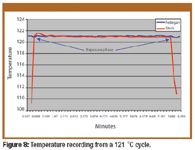
Figure 8
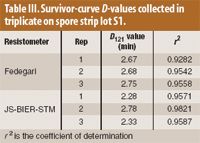
Table III. Survivor-curve D-values collected in triplicate on spore strip lot S1.
Steris resistometers. Both Steris resistometers operated as described in the ISO standard. The temperature recording from a 121 °C cycle is shown in Figure 8. Fedegari data from Figure 3 also are presented for comparison purposes.
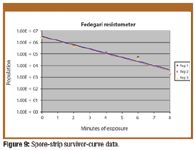
Figure 9
Survivor curve: spore strip. Survivor-curve data collected on the spore-strip lot S1 are shown in Table III. In the Fedegari, D-values were calculated to be 2.7 min in all three trials. In the Steris resistometer, D-values ranged from 2.3 min to 2.8 min (see Figures 9 and 10).
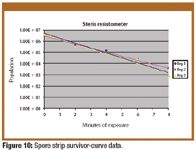
Figure 10
Fraction negative: spore strip. Fraction-negative data collected on the spore strip lot S1 are presented in Table IV. In all three resistometers, D 121-values were 1.5 min.
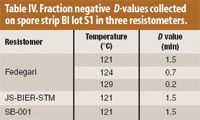
Table IV. Fraction negative D-values collected on spore strip BI lot S1 in three resistometers.
Fraction negative: self-contained BI. Fraction-negative data collected on the self-contained BI lot# SC1 are shown in Table V and Figure 11. Fraction-negative data collected on the self-contained BI lot SC2 are shown in Table VI and Figure 12. Fraction-negative data collected on the self-contained BI lot SC3 and SC4 are shown in Table VII.

Table V: Fraction-negative D-values collected in triplicate on self-contained BI lot SC1 in three resistometers.
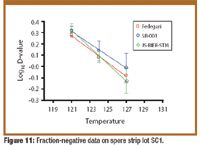
Figure 11

Table VI: Fraction negative D-values collected in triplicate on self-contained BI lot SC2 in three resistometers.
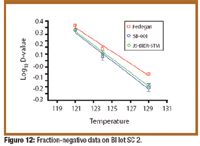
Figure 12
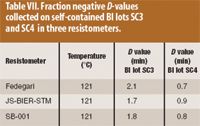
Table VII. Fraction negative D-values collected on self-contained BI lots SC3 and SC4 in three resistometers.
Fraction negative: ampul BI. Fraction-negative data collected on the ampul BI lot A1 are shown in Table VIII and Figure 13.

Table VIII: Fraction negative D-values collected in triplicate on ampoule BI lot A1 in three resistometers.
Conclusion
Operational parameters of the Fedegari are not identical to the Steris resistometers; however, data collected during this study demonstrated that the Fedegari vessel performs parametrically as a resistometer. Results from the various resistometers were comparable with respect to the measured resistance of the tested indicators. Less variation was obtained with the Fedegari BIER for all but the ampul BI. Slight differences in determined resistance between the BIER units are to be expected and are typical of replicate results from any single BIER unit. The Fedegari BIER provided equivalent performance to the more traditional BIER design in a more versatile and cost-effective system.
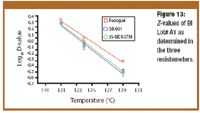
Figure 13
References
1. ANSI/AAMI/ISO 18472:2006, Sterilization of Health Care Product—Biological and Chemical Indicators: Test Equipment (International Organization for Standardization, Geneva, Switzerland).
2. ANSI/AAMI/ISO 11138-1:2006, Sterilization of Health Care Product—Biological Indicators, Part 1: General Requirements (International Organization for Standardization, Geneva, Switzerland).
James Agalloco is president of Agalloco & Associates (Belle Mead, NJ). Kurt McCauley is the research and development manager and John R. Gillis* is the president and CEO of SGM Biotech, 10 Evergreen Drive, Suite E, Bozeman, MT 59718, tel. 406.585.9535, fax 406.585.9219, info@sgmbiotech.com, www.sgmbiotech.com.
*To whom all correspondence should be addressed.
<WEBLINK>
For additional resources and online exclusives on this topic, visit pharmtech.com.

Drug Solutions Podcast: A Closer Look at mRNA in Oncology and Vaccines
April 30th 2024In this episode fo the Drug Solutions Podcast, etherna’s vice-president of Technology and Innovation, Stefaan De Koker, discusses the merits and challenges of using mRNA as the foundation for therapeutics in oncology as well as for vaccines.